El modelo Calderón: Carlos Fazio of La Jornada, a Uruguayan-born political scientist who survived an assassination attempt earlier this year after denouncing what he called “the journalism of infiltration” in the campaign mounted by Mexican mass media owners in support of PAN in last year’s elections, assesses the Felipe Calderón’s European tour.
One of the more interesting signs of the times this week is the transfer of the Internet domain odca.cl — the Web site of a Pinochetist party in Chile — to new owners. Administrative contacts: Manuel Espino, president of Mexico’s National Action Party (PAN) and Xavier Barrón, of Peru’s Partido Popular Cristiano.
See also my Spinning the World Backwards: Revolution and Counter-Revolution.
At the same time, this came over the press-release wires:
New Study: Mexican Political Polarization Limited to Elites Despite Contested 2006 Election
The topic: a symposium from the American Political Science Association, until recently headed by Harvard professor emeritus James Q. Wilson, the Ronald Reagan Professor of Political Science at Pepperdine University — author of From Welfare Reform to Character Development – and now by Robert Axelrod of U. Michigan’s Gerald Ford Center for Public Policy.
WASHINGTON, Jan. 24 /PRNewswire-USNewswire/ — New research by political scientists challenges the belief, widespread following the hotly contested 2006 presidential election, that Mexican society is divided by deep political divisions. The findings conclude that claims of such divisions are unsupported by recent field research and that a better understanding of the state of Mexican democracy depends on improved observation of politics among Mexico’s political elite — which are more polarized now than at any time since 1988. The research is presented in a special symposium entitled “The 2006 Mexican Election and its Aftermath,” and includes contributions by seven political scientists who have been heavily involved in generating new sources of data to analyze Mexican politics. The symposium appears in the January 2007 issue of PS: Political Science & Politics, a journal of the American Political Science Association (APSA).
The Chicago Boys, it seems, are back in business, and receiving massive support in the Latin American corporate media for the proposition that the choice between Pinochet-style dictatorship and direct democracy is a polarizing partisan issue.
The cold, hard question, I suppose, for the superior risk manager, is whether they can prevail, and whether the price of tortillas is consistent with Calderón’s pledge to “guarantee the security of foreign investments in Mexico.”
I tend to think that publications like La Jornada are the canary in the coal mine in this respect.
It is not a good sign for the Autonomous University-published daily, for example, that men linked to the 1968 Tlateloco massacre — and allegedly to the narcotraffic as well — are now firmly in charge of Mexico’s military.
I have a running bet with a foreign correspondent friend and colleague here that press freedom will soon be more explicitly curtailed — jailings and mass firings of journalists and installation of government shills in the key editorial positions, and draconian legal action, rather than the odd one-off assassination by glue-sniffing rent-a-sicários and their cousins from the local force – and that other aspects of a permanent state of exception will soon be explicitly evident in Calderón’s policies.
On the other hand, the freedom with which dailies like El Universal are going after massive corruption in the Fox administration, giving a wider audience to the work of investigative journalists like Miguel Badillo, Proceso, and Zeta, indicates that the polarization of Mexico’s “elites” could actually be the decisive factor here.
You might feel reassured by the notion that political polarization in Mexico is “confined to the elites,” but then again, you might well have your head firmly up your ass if you buy that notion without duing the due diligence on the downside risk.
See also “The Surprising Competence of Calderón the Harvard-Educated Technocrat.”
The emerging markets funds loved Zedillo, too, recall.
It is not a hard and fast rule, true, but as a rule of thumb, I find that journalists who get assassinated for reporting on corruption in high places are not generally assassinated because they are chasing phantasms in the night.
Therefore, I translate Mr. Fazio’s analysis, on the theory that there is at least a slight chance that this point of view represents a downside risk to the strategy of armed liberation of markets kept closed by “populist dictators.”
Calderón was elected with 35% of the vote in an election with 60% turnout, according to Wikipedia –I thought I saw a much lower figure the other day, let me check that — and as Brazil’s Lula pointed out at Davos, while Chávez was reelected in 2006 with some 63% of the vote in an election with 75% turnout. Lula was reelected with 61% of the vote and 83.2% turnout.
Systematic election fraud — at the national level, at least — has not been alleged by anyone in Venezuela or Brazil, that I know of.
El modelo Calderón
Con una diplomacia de “mercado”, oportunista y sin principios, y un discurso y prácticas políticas de corte ultraconservador propios de la guerra fría, Felipe Calderón y el Partido Acción Nacional se aprestan a ser más funcionales a Estados Unidos en su proyecto de reconquista en América Latina.
With a “market driven” diplomacy, opportunistic and devoid of principle, Felipe Calderón and PAN are in a hurry to sign up as employees of the United States in its project to reconquer Latin America.
En Davos, Suiza, al más puro estilo foxista, Calderón alabó al “libre mercado” y criticó las expropiaciones, las nacionalizaciones y las “dictaduras personales vitalicias”. En México, Manuel Espino, un anticomunista cerril que preside al PAN y a la Organización Demócrata Cristiana de América (ODCA), anunció que la derecha “va por todo” en Latinoamérica, con la mira puesta en tres objetivos principales: Cuba, Bolivia y Venezuela; los mismos que figuran en la agenda subregional de Washington.
In Davos, Calderón praised “the free market” in the purest tradition of Vincente Fox and criticized expropriations, nationalizations and “personal dictators for life.” In Mexico, Manuel Espino, the crude anticommunist who presides over PAN and the Christan Democrat Organization of America, announced that the right “is going for it” in Latin America, with its eye on three objectives: Cuba, Bolivia and Venezuela, the same targets that loom largest in the regional agenda of Washington.
Lo paradójico, en la coyuntura, es la guerra fratricida entre las “familias” y las facciones panistas. La encarnizada disputa por el poder y la hegemonía del modelo de extrema derecha que encarnan Calderón y Acción Nacional en la actualidad, reapareció en los últimos días a través del enfrentamiento entre gobiernistas y foxistas. Ciertamente, la ultraderecha no es unívoca; hay variaciones dentro de un mismo credo. Pero en rigor se trata de una pelea entre matices de una misma expresión política y económica que abraza la ideología neoliberal, impulsa el capitalismo salvaje y sirve de manera subordinada a los intereses geopolíticos de Estados Unidos y sus intentos restauradores en el hemisferio.
What is paradoxical, in this scenario, is the ongoing fratricidal warfare among the “families” and factions of PAN. The bloody dispute for power and the hegemony of the extreme right-wing paradigm that Calderón and PAN represent has resurfaced recently in the confrontation between the government faction and the Fox faction. To be sure, the extreme right has never spoken with one voice; there are divergences within the basic creed. But essentially this represents a struggle among adherents to a political and economic faith that embraces neoliberalism, savage capitalism and the subordination of Mexico to the geopolitical interests of the United States and its project to restore hegemony in the hemisphere.
A notorious case in Mexico at the moment, covered closely by El Universal, involves the alleged murder for hire of a PAN official who was investigating corruption in allocation of state government budget resources to municipalities.
One of persons arrested for the crime was PAN’s state party president in Guerrero, where the escalation of government-narco ultraviolence currently threatens the Acapulco tourist trade. See PANdemonium in Guerrero.
En marzo de 2005, cuando Espino se hizo de la presidencia del PAN, Juan Ignacio Zavala, integrante de una “familia” panista de prosapia y hermano de Margarita Zavala, actual primera dama de México, dijo que era el triunfo de “la derecha radical (llámesele ultra, Yunque o lo que sea)”. Y definió a Espino como un “cruzado”. Eran los días en que Tatiana Clouthier renunciaba al partido diciendo que Acción Nacional “era una mala copia del PRI”.
In March 2005, when Espino assumed the presidency of PAN, Juan Ignacio Zavala, member of a prominent PANist family and brother-in-law of Calderón, said that his election was the triumph of “the radical right (call it the ultraright, El Yunque, or whatever you like).” He defined Espino as a “crusader.” Those were the days when Tatiana Clouthier renounced the party, saying that PAN “was a bad copy of the PRI.”
And that it openly peddled influence, yes.
A charge apparently born out by the lion’s share of government appointments garnered by proteges of Elba Ester Gordillo of late.
Zavala is the proprietor of Hildebrando, an IT consultancy hired by the federal election commission to run Mexico’s electronic vote-count system. His firm also contracted with Gil Díaz’s infamous ISOSA to work in the Mexican Customs service.
Ya existían nexos entre gobernadores y dirigentes panistas con las mafias del crimen organizado (verbigracia el ex senador Diego Fernández de Cevallos y el ex gobernador de Morelos, Sergio Estrada Cajigal), pero todavía no irrumpían el canibalismo político, los usos y abuso del poder y los asesinatos interpares.
Links between PAN governors and party officials and organized crime already exist — for example, ex-Sen. Diego Fernández de Cevallos and ex-Gov. of Morelos, Sergio Estrada Cajigal), but have yet to erupt in political cannibalism, the uses and abuses of power and internecine assassinations.
Fernández de Cevallos, who ran against Zedillo and lost what is now recognized as a massively fraudulent election, authored the so-called Ley Televisa, which protected the Televisa-Azteca media duopoly against outside and domestic competition. See also Mexico’s Armed Media Monopoly.
Estrada Cajigal had a corruption case against him thrown out by the Supreme Court, with firm backing from Vincente Fox. Charges brought by state legislators of the PRD and PRI included vote buying and aiding and abetting a corruption scheme involving the top state law enforcement official and the narcotraffic.
De la mano del entonces presidente Vicente Fox y su esposa Marta Sahagún, la victoria de Espino en el PAN significó la entronización y consolidación de la extrema derecha sectaria, facciosa y dogmática en las estructuras de poder estatal y partidario. La irrupción, en posiciones de mando, de aquella derecha que en los años sesenta y setenta había anidado en los círculos ultraconservadores semisecretos del Movimiento Universitario de Renovadora Orientación (MURO), de El Yunque y otras expresiones vernáculas del neofascismo militante. Fue, el suyo, el triunfo de la derecha dentro de la derecha. La victoria de los “duros”, del neopanismo encarnado por los “bárbaros del norte” de claro acento anticomunista empresarial, que apoyara a mediados de los años ochenta el embajador John Gavin desde la misión diplomática de Estados Unidos en la Ciudad de México.
Handing a defeat to then-President Fox and his wife, Espino’s victory represented the triumph and consolidation of an extreme, sectarian and dogmatic right wing in the party and the state governments. This tendency, which in the 1970s had gone to ground inside semisecret ultraconservative circles and MURO (the University Movement for Renewal), El Yunque, and other militant neofascist groups, was now in power. Espino’s victory was the triumph of the right wing of the right wing. It was the victory of the “hardliners” of neo-PAN, embodied by “The Barbarians of the North” and their pro-business anticommunism, who in the 1980s had been supported by U.S. Ambassador John Gavin from the U.S. Embassy in Mexico City.
El iluminado Espino y su “humanismo centro-reformista cristiano” de fachada, expresa una nueva forma de fundamentalismo político-religioso, donde la acción política se concibe como una misión salvadora y purificadora. Su “matiz”, que como en tiempos de la campaña electoral intentará recuperar y capitalizar ahora con fines de dominio hegemónico el presidente Calderón, estuvo dado por un beligerante integrismo de cruzada contra el “populismo radical” según la expresión acuñada por el ex jefe del Comando Sur del ejército de Estados Unidos, general James Hill, representado en México por Andrés Manuel López Obrador, a quien, siguiendo el libreto ideológico de Washington, Espino, su jefe Fox y el candidato Calderón, asimilaron con fines de propaganda al presidente de Venezuela, Hugo Chávez tildado de “dictador”, “mesiánico” y “demagogo”, con el objeto de arrancar un voto de odio y de miedo en los comicios de julio de 2006.
The enlightened Espino and his facade of “center-reformist Christian humanism” represents a new form of politico-religious fundamentalism in which political action is conceived in terms of salvation and purification. ….
Poco tiempo le duró al presidente Calderón su “vocación” latinoamericanista y sus amagues retóricos de revertir la animadversión bilateral generada por la majaderías de Fox con los gobiernos de Cuba, Venezuela, Bolivia y Argentina, de la mano del aventurero anticastrista Jorge El Nene Castañeda y su sucesor en la cancillería, Ernesto Derbez.
It did not take Calderón long to abandon his “Latin-Americanist” vocation and his rhetorical support for reversing the bilateral tensions created by Fox’s quarrels with Cuba, Venezuela, Bolivia and Argentina, authored by the anti-Castro adventure Jorge Castañeda and his successor in the foreign ministry, Ernesto Derbez.
Las supuestas señales en pro de un “acercamiento”, enviadas a Cuba y Venezuela por la actual secretaria de Relaciones Exteriores, Patricia Espinosa, si acaso existieron, son parte de un doble juego exhibido sin rubor por Manuel Espino, quien acaba de declarar que las cruzadas del PAN y la ODCA para llevar la “democracia” a esos países, está en total sintonía con la diplomacia de Calderón. Y tiene razón el mesiánico Espino: la política exterior de México está atada y bien atada a la Alianza para la Seguridad y la Prosperidad de América del Norte (ASPAN), uno de los instrumentos de Washington para subordinar a Calderón a los afanes geoestratégicos, los intereses y la seguridad nacional de Estados Unidos.
The supposed overtures in favor of rapprochement, sent to Cuba and Venezuela by the current foreign secretary, Patricia Espinosa, if they ever existed, are part of a double game celebrated without blushing by Espino, who has just publicly announced a crusade by PAN and the ODCA to bring “democracy” to those countries — a message in total harmony with Calderón’s diplomacy. And the messianic Espino is correct: The foreign policy of Mexico is closely tied to the North American Union [for Prosperity and Security] , one of Washington’s instruments for subordinating Calderón to its geostrategic ambitions and to the interests and national security of the United States.
Anybody old enough to remember the Greater East-Asian Co-Prosperity Sphere?
Como declaró el mercenario de origen cubano Marcelino Miyares, invasor de Bahía de Cochinos en 1961 y vicepresidente de la ODCA, Calderón es “el modelo a seguir” para la derecha latinoamericana. La propuesta de la ODCA para infundir los valores de la “cultura occidental y cristiana” y combatir el “comunismo” de Fidel Castro y Hugo Chávez en la región, reproduce los lineamientos de la Comisión de Ayuda a una Cuba Libre que impulsa la secretaria de Estado estadunidense, Condoleezza Rice, con apoyo de la industria de la contrarrevolución con sede en Miami.
As the Cuban-born mercenary Marcello Miyares, a Bay of Pigs veteran and vice-president of ODCA, has stated, Calderón is “the model to follow” for the Latin-American right. The ODCA’s project to instill the values of “Western Christian civilization” and combat the “communism” of Castro and Chávez in the region reproduces the general orientation of the Committee for a Free Cuba that is driving Condoleeza Rice, with the support of the counter-revolution industry headquartered in Miami.
En el marco de la doctrina de guerra preventiva de la administración de Bush, un anexo secreto del último informe de la comisión, con evidentes propósitos militares, está dirigido a acelerar la desestabilización de Cuba en el marco de la convalecencia del presidente Castro. En ese contexto, todo indica que Calderón, Fox y Espino seguirán haciendo el trabajo sucio a Washington.
Within the framework of Bush’s doctrine of “preventive war,” a secret appendix to the commission’s latest report, with clear military implications, is dedicated to acclerating the destabilization of Cuba while Castro convalesces. In this context, all indications are that Calderón, Fox and Espino will continue to do Washington’s dirty work.
Disclosure: As someone proposing to live and do modest business in Brazil in the long term — I am married to a Brazilian beauty and have the legal right to whelp gringo-Tupi dual citizens if I so desire — I tend to worry that the winds of change might turn in a direction that will turn my pleasant neighborhood in São Paulo, with its ramshackle infrastructure, chattering bird life and marvelous neighbors, into a freaking Third World hellhole.
The recent announcement of military cooperation between Venezuela and Iran, in view of the noises that Bush is making — and the extra carrier group that is working out on Somalia in preparation for taking out targets in downtown Teheran — scares the living bejesus out of me.
And you?
Do you really think that this worst-case scenario is still going to be good for business?
My free advice, then, is not to underestimate the probability of the worst-case scenario coming to pass, no matter what you read on the edistorial pages of the W$J or the Chicago Tribune.
gaboenrebelion








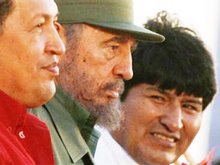
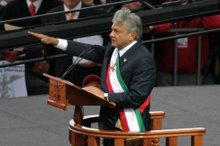

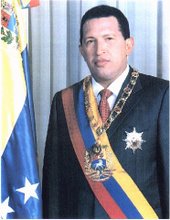
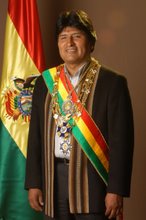
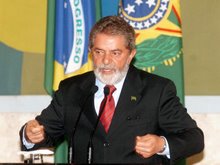




No hay comentarios.:
Publicar un comentario